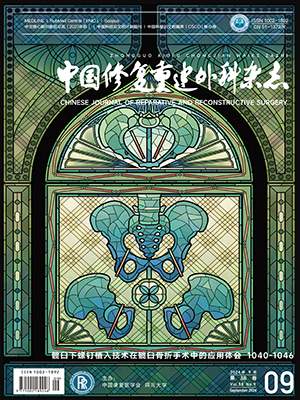| 1. |
程国良. 不同形式的足趾移植拇手指再造与修复. 中华显微外科杂志, 2002, 25(1): 8-9.
|
| 2. |
孙广峰, 魏在荣, 王利达, 等. 趾腓侧皮瓣游离移植修复手指掌侧皮肤缺损. 中国修复重建外科杂志, 2011, 25(4): 510-512.
|
| 3. |
马立峰, 刘良燚, 李木卫, 等. 游离第二趾胫侧皮瓣修复手指中末节皮肤软组织缺损. 中华显微外科杂志, 2013, 36(6): 603-605.
|
| 4. |
梁文仙, 匡星, 郑悦, 等. 手显微外科智能温控清创装置及其可调托架一体化的研制与应用. 实用手外科杂志, 2014, 28(2): 235-237.
|
| 5. |
潘达德, 顾玉东, 侍德, 等. 中华医学会手外科学会上肢部分功能评定试用标准. 中华手外科杂志, 2000, 16(3): 130-135.
|
| 6. |
谢松林, 唐举玉, 陶克奇, 等. 指固有动脉背侧支为蒂的逆行掌指背筋膜皮瓣的应用解剖. 中国临床解剖学杂志, 2010, 28(1): 97-100.
|
| 7. |
吴迪, 周围, 梁敏, 等. 近节指动脉背侧皮支皮瓣的临床应用. 中华显微外科杂志, 2011, 34(6): 492-493.
|
| 8. |
钟世镇, 丁自海, 杜心如, 等. 临床解剖学丛书—脊柱与四肢分册. 2版. 北京: 人民卫生出版社, 2014: 109-110.
|
| 9. |
周吉林, 姜华东, 张晓明, 等. 拇指指背动脉的应用解剖. 中国临床解剖学杂志, 2001, 19(4): 333-334.
|
| 10. |
熊秉刚, 欧翰杰, 陈健, 等. 拇趾腓侧微型组织瓣的解剖及临床应用. 中国美容整形外科杂志, 2013, 24(2): 95-97.
|
| 11. |
牟勇, 黄东, 吴伟炽, 等. 以趾背动脉为血供的趾背皮瓣应用解剖. 中国临床解剖学杂志, 2010, 28(6): 618-619.
|
| 12. |
胡德锋, 赵晓航, 马建安, 等. 趾趾背动脉皮瓣的应用解剖. 中国临床解剖学杂志, 2014, 32(1): 5-7.
|
| 13. |
陈乐锋, 张振伟, 游楚红, 等. 中指近节桡侧指动脉邻指逆行岛状皮瓣修复拇指指端缺损. 中华手外科杂志, 2014, 30(1): 44-46.
|
| 14. |
章剑, 谢振军, 赵国红, 等. 掌背筋膜蒂岛状皮瓣修复示中指皮肤缺损. 中华手外科杂志, 2015, 31(6): 477.
|
| 15. |
刘志功, 马广山, 冯会祥, 等. 拇指背侧逆行皮瓣的临床应用. 实用手外科杂志, 2012, 26(2): 117-119.
|




